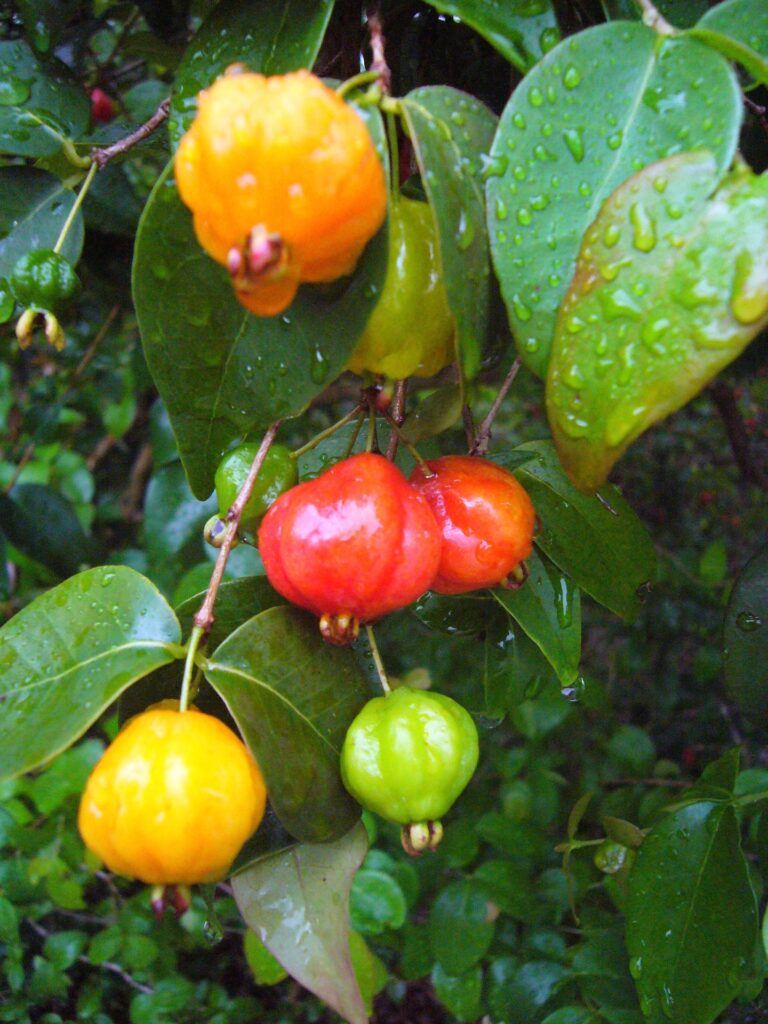
The red ripe fruit is sweet and acidic, not everyone likes them. Photo by Green Deane
Surinam cherries are like small eight-ribbed pumpkins. If deep red they are tasty, but not all people like them. If orange red they are unripe and taste awful, like their seeds. One species has ripe fruit that is dark purple, almost black, and is very sweet. Some fruits are beginning to ripen now though their season is just starting.
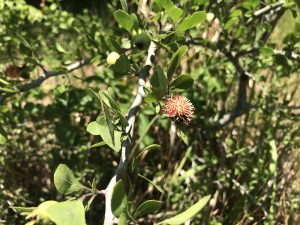
Gall on a Hawthorne. photo by Green Deane
Shall we get technical? Most foragers would look at this picture right and say that is a gall. beginners might think it’s a strange fruit . Plant galls are defined as abnormal plant growths caused by a gall-maker; the gall-maker being certain insects, mites, fungi, and bacteria. Locally Persea Borbornia usually has a lot galls — one of the identifying characteristics — and one particular scrub oak gets galls that look like cranberries.
This is a gall on a Hawthorn fruit and is a fungus, Gymnosporangium clavipes, which is responsible for the disease known as Cedar-Quince Rust. The “cedar” in the relationship is actually the eastern red cedar, which is really a juniper, Juniperous virginana. This fungus must alternate between junipers and a member of the rose family, such as quince, hawthorn, crabapple, etc., to complete its life cycle. It spends a year on plant in the two groups then a year on the other plant.
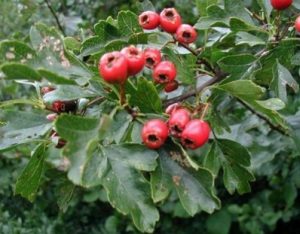
Ripe Hawthorn fruit. Photo by Green Deane
Hawthorns are an unusual group of trees and can live to 400 years old. No one really knows how many species there are two hundred or 1,200. It is safe to say they vary a lot so identifying which one you have can be quite frustrating. The fruit is edible but not the seeds, and the fruit and leaves dried as a tea can be used for high blood pressure. Three grams of dried powdered leaves morning and night has been validated as an effective beta blocker and lowers blood pressure.
Across the dirt road I grew up on in Maine was a large hawthorne with two-inch thorns. Different species of birds would nest in the tree at the same time, because the thorns dissuaded egg and chick predator. Unnecessary tarring and widening of the road eliminated the tree.
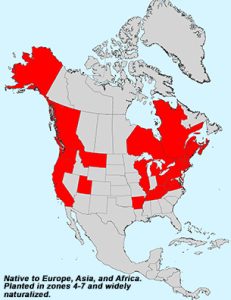
Range of the one-seeded Hawthorn
Historically hawthorns have been used to make hedgerows and “haw” means hedge. The fruit is a source of pectin. In fact one, Crataegus monogyna, the one-seed Hawthorn can be made into a no-cook jelly. Put the berries in a bowl and quickly crush them thoroughly with your hands. The resulting liquid should be about the consistency of pudding just before it sets. It should be that consistency naturally. If you’ve had a dry year add some water to get to that consistency. Work quickly. Squeeze the seeds out of the berries then quickly filter the thick slurry into a bowl. In about five minutes the liquid will jell. Flip it over onto a plate. It can be eaten as is or sliced or sun dried. It will be sweet and will last for many years. Remember just ripe berries have more pectin than over-ripe berries. To see a video on this go here.
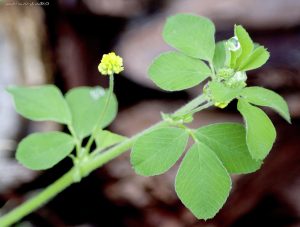
Blak medic resemles Hop clover. Photo by Green Deane
You’re probably seeing a lot of this or will be seeing a lot of it and wondering what the species is. This little plant with the little yellow blossom is Black Medic. It’s generally considered edible and like many weeds is from Europe. That kind of excludes it from being a significant Native American food (though some sources call it that… It’s a long story.) The headache is that from a distance of about five or six feet (where most people’s eyes are from the ground) Black Medic can look like Hop Clover. Here’s quick way to tell them apart: Hop Clover tends to have red stems, Black Medic has green stems covered with fine white hair and has a longer stem on the center leaf. After the two species go to seed they are easy to sort out: Black Medic has black seeds… hence the name. Hop Clover brown seeds. I personally don’t view Black Medic as much of an edible but you can read more about it here.
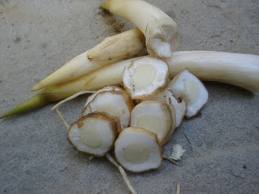 If you were starving and came upon a patch of cattails (blossoming now) you would have great cause for celebration. You have found food and water. You will survive. But if you are not starving and do not have all the time in the inter-connected world you just might find cattails highly overrated. It is true that no plant can produce more starch per acre than cattails, about 3.5 tons under cultivation. And it can produce a lot of starch economically if you can mechanize the extraction. But hand extraction is time-consuming and labor intensive. It is also wet, smelly work all of which can be worsened significantly by harvesting in cold weather. So yes, cattails are food but the time demand is such that harvesting food has to be your prime occupation. A similar argument can be made for kudzu, though a lot more effort i required. The roots do have edible starch but it takes a gargantuan amount of work to get the starch out, literally hours of steady pounding. It is not a calorie positive activity. That moves you closer to starvation. But, mechanize the process with some hammers run by falling water — or hammers run by a horse fed on an endless supply of grass — and kudzo becomes a reliable calorie-positive food. You can see my video on cattails here. I also have an article on Finding Caloric Staples with links to relevant videos.
If you were starving and came upon a patch of cattails (blossoming now) you would have great cause for celebration. You have found food and water. You will survive. But if you are not starving and do not have all the time in the inter-connected world you just might find cattails highly overrated. It is true that no plant can produce more starch per acre than cattails, about 3.5 tons under cultivation. And it can produce a lot of starch economically if you can mechanize the extraction. But hand extraction is time-consuming and labor intensive. It is also wet, smelly work all of which can be worsened significantly by harvesting in cold weather. So yes, cattails are food but the time demand is such that harvesting food has to be your prime occupation. A similar argument can be made for kudzu, though a lot more effort i required. The roots do have edible starch but it takes a gargantuan amount of work to get the starch out, literally hours of steady pounding. It is not a calorie positive activity. That moves you closer to starvation. But, mechanize the process with some hammers run by falling water — or hammers run by a horse fed on an endless supply of grass — and kudzo becomes a reliable calorie-positive food. You can see my video on cattails here. I also have an article on Finding Caloric Staples with links to relevant videos.
With the moderation of the weather foraging classes become more enjoyable.

Classes are held rain or shine (but not during hurricanes.)
Saturday, April 27th, Mead Garden: 1500 S. Denning Dr., Winter Park, FL 32789. Meet at the bathrooms. 9 a.m. to noon.
Sunday, April 28th, Colby-Alderman Park: 1099 Massachusetts Street, Cassadaga. Fla. 32706. meet at the bathrooms, 9 a.m. to noon.
Saturday, May 4th, Eagle Park Lake, 1800 Keene Road, Largo, FL 33771. Meet at the pavilion near the dog park. 9 to noon.
Sunday, May 5th, Boulware Springs Park, 3420 SE 15th St., Gainesville, FL 32641. Meet at the picnic tables next to the pump house. 9 a.m. to noon.
For more information on these classes, to prepay or sign up go here.

Green Deane Forum
Tired of Facebook and want to identify a plant? The Green Dean Forum is up and running again. Have you come to dislike Facebook, then join us on the forum. Perhaps you’re looking for a foraging reference? You might have a UFO, an Unidentified Flowering Object, you want identified. On the Green Deane Forum we — including Green Deane and others from around the world — chat about foraging all year. And it’s not just about warm-weather plants or just North American flora. Many nations share common weeds so there’s a lot to talk. There’s also more than weeds. The reference section has information for foraging around the world. There are also articles on food preservation, and forgotten skills from making bows to fermenting food.

You get the USB, not the key.
172-video USB would be a good end of spring present and is now $99. My nine-DVD set of 135 videos has been phased out. The USB videos are the same videos I have on You Tube. Some people like to have their own copy. Most of the 172 USB videos have to be copied to your computer to play. If you want to order the USB go to the DVD/USB order button on the top right of this page. That will take you to an order form.
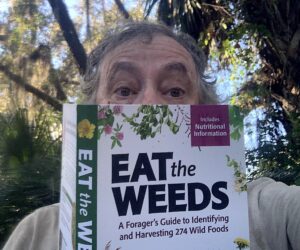
Finally, a physical copy of the book.
Now in its second printing is EatTheWeeds, the book. It has 274 plants, 367 pages, index, nutrition charts and color photos. It’s available in many locations including Amazon. Most of the entries include a nutritional profile. It can also be ordered through AdventureKeen Publishing.
This is weekly newsletter #598. If you want to subscribe to this free newsletter you can find the sign-up form in the menu at the top of the page.
To donate to the Green Deane Newsletter click here.

